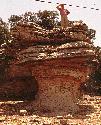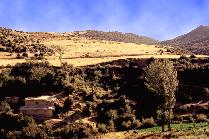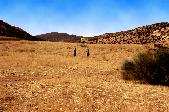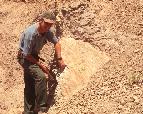Here are some photos taken during different visits to Morocco. Most of these are from field work conducted in the Middle Atlas region where I have been focussing my dissertation research. To read more about the research in the Middle Atlas, as well as the rest of Morocco, click here.
(click on an image for a larger version.)
 Here's
the obligatory camel photo on the High Plateau (Oran Meseta). The High
Plateau has a mean elevation of about 1200 meters, and it is very flat.
It covers a large area from eastern Morocco to eastern Algeria between
the Tel Atlas (the Alpine collisional belt) and the High Atlas/Saharan
Atlas. The western limit of the High Plateau is the Middle Atlas fold belt.
Here's
the obligatory camel photo on the High Plateau (Oran Meseta). The High
Plateau has a mean elevation of about 1200 meters, and it is very flat.
It covers a large area from eastern Morocco to eastern Algeria between
the Tel Atlas (the Alpine collisional belt) and the High Atlas/Saharan
Atlas. The western limit of the High Plateau is the Middle Atlas fold belt.
 This
is a photo (facing northwest) of the southeastern front of the Middle Atlas.
The Middle Atlas mountains have a mean elevation of of 2000 meters in the
southern and central region and 2500 meters in the north. Some peaks in
the north attain an elevation greater than 3600 meters.
This
is a photo (facing northwest) of the southeastern front of the Middle Atlas.
The Middle Atlas mountains have a mean elevation of of 2000 meters in the
southern and central region and 2500 meters in the north. Some peaks in
the north attain an elevation greater than 3600 meters.
 This
is a typical sequence of the Lower Jurassic (Lias) strata from the central
Middle Atlas. The base of the sequence consists of massive dolomite beds.
This is followed by interbedded limestone and marl. In this photo, two
thick layers of marl can be seen about two-thirds of the way up the hill
(the red layer and the gray-green layer). This sequence is capped at the
top by a very resistant, massive limestone.
This
is a typical sequence of the Lower Jurassic (Lias) strata from the central
Middle Atlas. The base of the sequence consists of massive dolomite beds.
This is followed by interbedded limestone and marl. In this photo, two
thick layers of marl can be seen about two-thirds of the way up the hill
(the red layer and the gray-green layer). This sequence is capped at the
top by a very resistant, massive limestone.
 Strange
erosional landforms! This is an interesting outcrop of the Lower Jurassic
(Middle Lias) layered limestone and marl, typical of the Middle Atlas.
That's Weldon
Beuchamp perched atop the rock.
Strange
erosional landforms! This is an interesting outcrop of the Lower Jurassic
(Middle Lias) layered limestone and marl, typical of the Middle Atlas.
That's Weldon
Beuchamp perched atop the rock.
 This
is a photo of the Ait Oufella thrust fault along the southeastern front
of the central Middle Atlas. The fault is niceley exposed in a road cut
at the village of Ait Oufella. Here, Triassic argillite and atlered basalt
(the reddish brown rocks) are thrust over Late Neogene and Early Quaternary
continental deposits (the tan rocks). The dip of the fault here is about
35 degrees.
This
is a photo of the Ait Oufella thrust fault along the southeastern front
of the central Middle Atlas. The fault is niceley exposed in a road cut
at the village of Ait Oufella. Here, Triassic argillite and atlered basalt
(the reddish brown rocks) are thrust over Late Neogene and Early Quaternary
continental deposits (the tan rocks). The dip of the fault here is about
35 degrees.
 About
15 km southwest of Ait Oufella, the frontal fault, we have found the fault
to affect stream terraces. At this location, there are two well developed
terraces about 10 meters and 3 meters above the present stream level. This
photo depicts the upper terrace. The steep slope coincides with the Ait
Oufella fault exposed in the canyon. The lower terrace (not shown here)
is discontinuous across the fault zone.
About
15 km southwest of Ait Oufella, the frontal fault, we have found the fault
to affect stream terraces. At this location, there are two well developed
terraces about 10 meters and 3 meters above the present stream level. This
photo depicts the upper terrace. The steep slope coincides with the Ait
Oufella fault exposed in the canyon. The lower terrace (not shown here)
is discontinuous across the fault zone.
 Another
view of the faulted stream terrace shown above. The Land Rover is parked
at the top, and the people stand at the base of the scarp. The scarp is
about 4 meters high.
Another
view of the faulted stream terrace shown above. The Land Rover is parked
at the top, and the people stand at the base of the scarp. The scarp is
about 4 meters high.
 Here's
an example of normal faulting along the thrust front of the Middle Atlas.
This photo (facing northeast) was taken near the village of Taouerda. About
10 meters of throw is depicted by the massive (lower Jurassic) limestone
beds. Similar (but less prominent) normal faults also affect Pliocene and
Quaternary to the right (east) of this photo. In this region, normal faults
appear to be superficial structures.
Here's
an example of normal faulting along the thrust front of the Middle Atlas.
This photo (facing northeast) was taken near the village of Taouerda. About
10 meters of throw is depicted by the massive (lower Jurassic) limestone
beds. Similar (but less prominent) normal faults also affect Pliocene and
Quaternary to the right (east) of this photo. In this region, normal faults
appear to be superficial structures.
 This
is a photo of Weldon
Beuchamp next to a small normal fault surface in the Tabular Middle
Atlas. At this location, Quaternary travertine is faulted against Lower
Jurassic carbonates. Normal faults are frequently observed in the Tabular
Middle Atlas (west of the fold belt) and appear to be related to extensional
steps and bends in strike-slip faults.
This
is a photo of Weldon
Beuchamp next to a small normal fault surface in the Tabular Middle
Atlas. At this location, Quaternary travertine is faulted against Lower
Jurassic carbonates. Normal faults are frequently observed in the Tabular
Middle Atlas (west of the fold belt) and appear to be related to extensional
steps and bends in strike-slip faults.
 The Ziz Gorge of the eastern High Atlas. This part of the Atlas is very
dry with the exception of the oases such as that found here. The exposure
of the Jurrassic carbonates is exceptional. This photo was taken during
my first visit to Morocco in the late Spring of 1994. Weldon (second from
the right) is with some Moroccan colleagues including (from left) Ahmed
Er-Raji (graduate student from University Mohammed V), Mohammed Zebrog
(driver from the Ministry of Mines and Energy), Mohammed (driver from ONAREP),
and Mohammed El-Algi (geologist from ONAREP).
The Ziz Gorge of the eastern High Atlas. This part of the Atlas is very
dry with the exception of the oases such as that found here. The exposure
of the Jurrassic carbonates is exceptional. This photo was taken during
my first visit to Morocco in the late Spring of 1994. Weldon (second from
the right) is with some Moroccan colleagues including (from left) Ahmed
Er-Raji (graduate student from University Mohammed V), Mohammed Zebrog
(driver from the Ministry of Mines and Energy), Mohammed (driver from ONAREP),
and Mohammed El-Algi (geologist from ONAREP).
 In
the High Atlas of Beni Mellal, one finds the Cascade d'Ouzoud. This scenic
location often appears on postcards and tourist brochures from Morocco.
This photo was taken during the dry season, but in the early and late Spring,
the discharge is much greater.
In
the High Atlas of Beni Mellal, one finds the Cascade d'Ouzoud. This scenic
location often appears on postcards and tourist brochures from Morocco.
This photo was taken during the dry season, but in the early and late Spring,
the discharge is much greater.
![]() return to main
page.
return to main
page.
page last modified January 23, 1998.